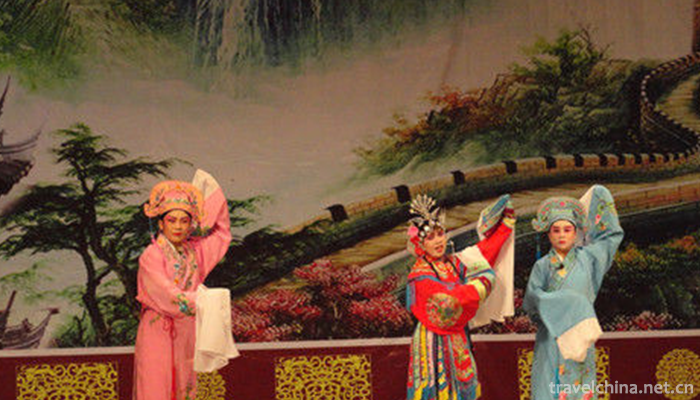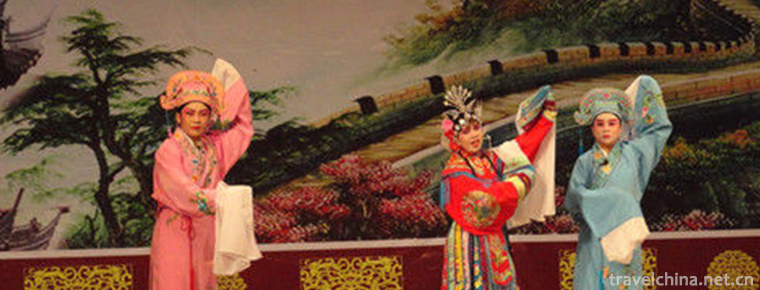Taoist Drama
Taoist Drama
Taoist sentiment is a category of traditional Chinese folk art. It originated from Taoist songs such as Chengtian and Jiuzhen in Tang Dynasty. The Southern Song Dynasty began to accompany with fishing drums and cylindrical boards, so it is also known as sentimental fishing drums. By the Qing Dynasty, Tao and sympathy combined with folk music in different places formed various forms of homology and divergence, such as Taikang Tao, Hongdong Tao, Northern Shaanxi Tao, Jiangxi Tao, Hubei Yugu, Sichuan Zhuqin and so on. Taoist sentiment is mainly composed of singing, supplemented by speaking. There are sitting singing, standing singing, singing, counterpart and other forms of performance.
Historical evolution
Taoist sentiment originated from the rhyme of Taoism in Tang Dynasty, which is a kind of poetry and praise. After the Song Dynasty, Cipai and Qupai were absorbed and evolved into a new classical rhyme, also known as Tao Song, sung in folk sermons. With fishing drum, simple board accompaniment, similar to drum words. Later, the poetry and praise style of Tao was mainly popular in the south, and it was the rap and singing style between the songs and the white ones. The opera style of Qupai style was popular in the north, and developed into the opera style in Shaanxi, Shanxi, Henan and Shandong. The opera style was mainly composed of playing children, soap-roe robes, and Qingjiang Yin. Qin opera and Gong-Drum and singing style were adopted, gradually forming the Tao opera of different parts of the country. 。 There are four kinds of operas: Taoist drama of ascending immortals, drama of cultivating virtues and persuading good people, drama of folk life, historical story and drama of legendary public cases. Some places are called fishing drums or bamboo piano.
In Shaanxi, there are two kinds of Shaanxi shadow play, one is the Eastern Tune and the other is the Western Tune. The former is prevalent on both sides of the Yellow River, while the latter is prevalent in northern Shaanxi and Inner Mongolia. In different areas, it has formed such sub-operas as "Northern Daoqing", "Shangluo Daoqing", "Ankang Daoqing" and "Xiliangdiao". Its singing style is characterized by the harmony of all people to enhance the atmosphere where the voice falls and drags. There are more than 200 plays, all of which are handed down by the old artists. Some of them have strong religious color.
Taoist sentiment is the predecessor of fishing drums. Taoist sentiment, also known as the "yellow crown body" (yellow crown may refer to the costume of Taoists), is the Taoist sentiment sung by Taoists. It is widely traveled, too empty to express feelings. It is called "Taoist sentiment" because of the thought of eating, dewing and clothing. The Tang Dynasty may have already had Tao songs, while the fishing drum and bamboo slips began in the Song Dynasty. Although Tao sentiment appeared early, few works have been handed down. Only ten passages of Zheng Banqiao's Tao sentiment can be seen. (Generally speaking, only the above five passages are included in the singing.) And Xu Dachun's feelings in Huixi Road. This kind of music has declined and will be extinct. Since the Republic of China, there has been no material left for us to learn. This art has been followed by nobody.
According to legend, there were seventy-two Divertimentos and more than one hundred tunes. Now only thirteen Divertimentos and ninety-six tunes can be collected, and their singing style is a combination. It uses some tunes of the Zhugong tunes to intertwine and form a large-scale aria with layers. Each divertimento has six different tunes: positive, negative, peaceful, bitter, grabbing and tight. The aria is composed according to the need when it comes. For example, the structure of "playing with children" includes six tunes: playing with children, playing with children in reverse, playing with children in peace, playing with children in distress, playing with children in rush and playing with children in urgent need. This "positive, negative, peaceful, bitter, rush and tight" has different contents: "positive" means singing in a positive tone, and the tune sung in a positive tone is generally "Shang" tone; "negative" means singing in a negative tone, and the tune sung in a negative tone is generally "Hui" tone; "peaceful" means general normal mood; "bitter" means sad and desolate mood; both are sung in a positive tone; "tight" means singing in a negative tone. It means that the structure of the aria is compact, and "grabbing" means that the structure of the aria is joyful, light and similar to the speed of "grabbing". In addition, Taoist sentiment also skillfully drew lessons from the "intermediary board", "flowing water", "rolling white" and Kunqu opera singing tune in "Jin Opera", which made up for its own shortcomings. The "fishing drum" in music accompaniment is a special instrument of Tao and Qing. Its instruments in Wenwuchang are roughly the same as those in Bangzi Opera.


-
1.Letinous edodes chicken Noodles
Letinous edodes stewed chicken originated in Northern Jiangsu
Time 2018-10-12 -
2.Inner Mongolia Autonomous Region Alshan Chaihe Tourist Scenic Area
Inner Mongolia Autonomous Region Alshan Chaihe Tourist Scenic Area/Chaihe Tourist Scenic Spot has a total area of 1368.7 square kilometers
Time 2018-12-02 -
3.The ancient city of Qingzhou
Qingzhou ancient city is one of the ancient nine states. It has a history of more than 7,000 years, a history of civilization of more than 5,000 years
Time 2018-12-08 -
4.Strange slope Scenic Area
Weipo Scenic Spot is located at the foot of Maoshan Mountain in Qingshuitai Town, Xinchengzi District, Shenyang City, Liaoning Province, facing the wilderness, backed by mountains
Time 2019-01-12 -
5.Babu Zhai soup
Babaozhai soup is a traditional dish of Guangdong Province, which belongs to Cantonese cuisine. The soup tastes elegant and light, fresh and tasty, nutritious and has strong nourishing function.
Time 2019-03-27 -
6.Yunnan Mengzi Crossing Bridge Rice noodles guo qiao mi xian
"Crossing bridge rice noodles" is a unique food in southern Yunnan. It originated in Mengzi City, Hani and Yi Autonomous Prefecture of Honghe. It has a history of more than 100 years. It wa
Time 2019-07-16 -
7.Fallen Drama zhui zi xi
Fallen Drama, a traditional drama in Shenze County of Hebei Province and Suzhou City of Anhui Province, is one of the national intangible cultural heritages.
Time 2019-08-16 -
8.Baoguang Temple
Baoguang temple is located in Xindu District, Chengdu City, Sichuan Province, China. It is one of the Buddhist temples with a long history, large scale, complete structure and quiet environment.
Time 2020-11-05 -
9.Huangze Temple
Huangze temple is the only temple for Empress Wu Zetian in China. It is located on the Bank of Jialing River in Guangyuan City, Sichuan Province. In 1961, it was listed as one of the first batch of national key cultural relics protection units by the State Council; in 2006, it was rated as a national AAAA tourist attraction.
Time 2020-11-08 -
10.Jianmen Shu Road
Jianmen Shudao is one of the first batch of national scenic spots, with jianmengguan as the core, starting from Ningqiang, Shaanxi in the north and Chengdu in the south, with a total length of 450 km. The culture of the three kingdoms along Jianmen Shu Road is profound. Pang Tong, Jiang Wan, Jiang Wei, Deng AI,
Time 2020-11-08 -
11.Dispute on the meaning of Cheongsam
Under the influence of the Qing Dynasty's Qiren's robes, women's gowns have been referred to as cheongsam since the Republic of China. Due to the influence of the environment at that time, most people know that the women of the Manchu and Qing Dynasty had their own cheongsam,
Time 2020-12-11 -
12.Deyang medical and health
By the end of 2018, Deyang City had 2819 health institutions (including village clinics), including 7 centers for Disease Control and prevention, 7 health supervision institutions, 1 Emergency Center (station), 6 maternal and child health centers,
Time 2020-12-14